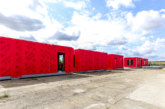 When it comes to duty of care, social housing providers have a huge responsibility, particularly with regard to fire safety in homes, says Ibrahim Imam, Co-Founder of PlanRadar. Since the tragic events at Grenfell, the industry is being reshaped by a myriad of legal changes. It’s a sign of the times — both the Fire Safety Act and the Building Safety Act reflect government intentions, and it has construction safety set firmly in its sights. For those that fail to get onboard, it will mean serious legal ramifications if standards aren’t met.
When it comes to duty of care, social housing providers have a huge responsibility, particularly with regard to fire safety in homes, says Ibrahim Imam, Co-Founder of PlanRadar. Since the tragic events at Grenfell, the industry is being reshaped by a myriad of legal changes. It’s a sign of the times — both the Fire Safety Act and the Building Safety Act reflect government intentions, and it has construction safety set firmly in its sights. For those that fail to get onboard, it will mean serious legal ramifications if standards aren’t met.
With fire safety top of the agenda, the sign-off process on new-build projects is also evolving. It’s now being prioritised earlier in the design phase for maximum effect, rather than being an afterthought once a project has been completed.
For social housing providers, the difficulty now lies in navigating this new legal framework and making sure that the Golden Thread of Information is being considered throughout every stage of construction. As a result, safety inspection platforms are becoming increasingly popular. With their ability to collect and collate important building data, as well as create a detailed digital record of relevant work — they represent an important next step in delivering fire safety in a landscape filled with increasing legal complexity.
Securing planning permissions
While safety inspection platforms are allowing site staff to undertake robust quality control inspections, providing clear proof that work is meeting industry standards, they also now play a key role in securing planning permissions. For new projects to be given the green light, they must first present a detailed and comprehensive record of intent on how fire safety will be delivered throughout every stage of the project. Planning Gateway One, introduced back in August last year, demands a detailed breakdown of fire safety design and procedures unique to each building. As part of this phase, a Health and Safety Executive consultee is also assigned to ensure that standards are being met[1]. Again, the message is clear — provide proof or projects won’t get off the ground.
Covering all angles
However, collating the relevant package of safety information isn’t an easy process and it requires attention to detail and industry-know how, often lead by a specific expert to get projects over the line. However, this is where safety inspection platforms come into their own — they’re able to simplify the process, so that it’s quicker and easier to access detailed information, all from one secure, online location. This isn’t just the case for new projects but existing buildings looking to ‘level up’ their fire safety offering — today’s software has the answers.
It’s also true of handovers — the stage of construction where specific details relating to fire safety can slip through the net, particularly in terms of ongoing Operations and Maintenance (O&M). Again, through detailed data capture, valuable information can be passed seamlessly to the likes of facilities managers, ensuring fire safety is properly managed and prioritised even after a project has been completed.
Reduce errors, improve safety
Errors in the construction phase is also an area where fire safety can be compromised. By giving site staff digital tools that allow them to recognise and resolve potential defects, the likelihood of mistakes is considerably reduced. In a recent McKinsey report on Digital Transformation in Construction, it notes “Digital tools can help accelerate construction by reducing defects and thereby reducing rework”.
 Some of the best performing AI-supported software is now able to record and send images and video of installations and completed work as well assign specific tasks to individuals for greater personal responsibility. It means that site managers or those in charge can be one hundred percent be sure that work has been carried out according to industry standards, even when working remotely.
Some of the best performing AI-supported software is now able to record and send images and video of installations and completed work as well assign specific tasks to individuals for greater personal responsibility. It means that site managers or those in charge can be one hundred percent be sure that work has been carried out according to industry standards, even when working remotely.
Working in this way is equally important when considering HSE (Health and Safety Executive) inspections. Evidence will undergo a vigorous examination process and providing detailed levels of proof will help resolve any potential question marks over completed work. HSE inspectors will be able to see what work was carried out, when and by whom — all through a tamperproof digital audit trail. This is also peace of mind for housing authorities, so that they can be sure work has been carried out to the appropriate standards.
Plus, without these tools in place, the mass gathering of information can be lengthy, prone to error and frustrating for safety inspectors who want the data they need to get their job done.
Leaving no stone unturned
For social housing providers, having an assurance that fire safety has been given the priority it needs is worth its weight in gold. The introduction of the Social Housing Regulation Bill[2] is placing more emphasis on building safety than ever before and with the government now naming and shaming social landlords that don’t meet acceptable criteria[3], it’s important that local authorities are able to stay one step ahead. Yet to do that, they must see digital tools and software as an ongoing investment that can help them provide the best service possible. It’s only through watertight fire safety controls that we can ensure events such as Grenfell never happen again and it starts with the right safety inspection platforms.
[1] https://www.gov.uk/guidance/fire-safety-and-high-rise-residential-buildings-from-1-august-2021#what-is-planning-gateway-one
[2] https://www.insidehousing.co.uk/insight/insight/social-housing-regulation-bill-how-will-the-changes-improve-tenant-engagement-76527
[3] https://www.insidehousing.co.uk/news/news/government-starts-naming-and-shaming-underperforming-social-landlords-76931









